Philadelphia Fringe Diary 2023 (Festival Concluded)
Once again, we reach the delights of Fringe season in Philadelphia. With new productions from local favorites such as Alterra Productions, and a wide variety of new and emerging artists, Philadelphia once again becomes the hub of innovation in immersive theatre on the East Coast.
This year’s festival features new venues, an expansion of immersive offerings at classic venues like the historic Laurel Hill Cemetery and new spaces, like the recently renovated Fallser Club. Below are a selection of reviews from the festival, from both established and emerging artists.

Midnight Dreamin’ — Ock the Wizard
$25, PWYC Options, Through September 27
There’s a challenge, when approaching outsider art, that a traditional critical framework isn’t going to be the appropriate lens with which to approach it. In a lot of ways, Midnight’ Dreamin fails as a traditional experience. Midnight Dreamin’ attempts to portray a fantastical garden in twilight, as if conjured in the dreams of the creator, Ock the Wizard. In this space, he receives guidance towards managing his bipolar disorder from the various Orishas (roughly translated as spirits, messengers of a supreme creator) of the Yoruba religion.
The execution is unpolished, to say the least. By the production team’s own admission, the show began 20 minutes late due to the team’s unfamiliarity with the venue, and the large-scale ambitions of their set. Beyond that, those constraints meant that the set, a key point of immersion, felt slapdash. Actors seemed slightly unsure of themselves; it was unclear whether this was intentional, but instead of introducing themselves as the characters, they would introduce themselves as actors and describe who they were portraying.
Still, I’m happy that this production was staged, and I’m happy to have attended. This was an invitation to take a peek into someone’s mind, and to support an emerging artist in his first foray into a theatrical experience. Despite the challenges, I felt a sense of connection with Ock the Wizard and a clear understanding of his worldview. Despite the difficulties and pitfalls of the production, I stand resolute that this is what Fringe is for.
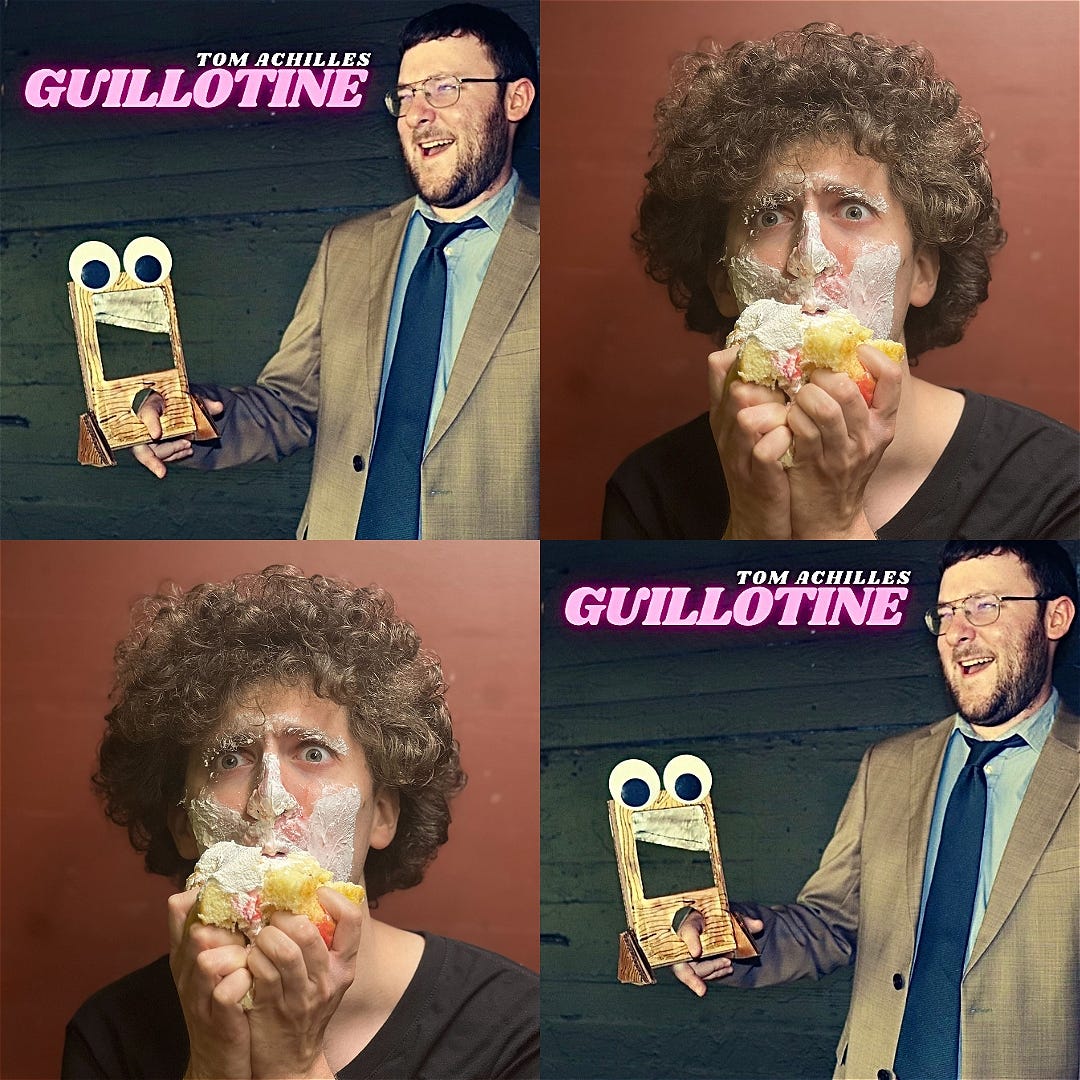
Split Bill:
johann johann: or thee wurst dinner partie — eat purple theatre co /
Tom Achilles: Guillotine — Tom Achilles
$25, PWYC Options, Through September 27
I come to immersive theatre, as an art form, to have experiences that I might dream of but that life continually thwarts. johann johann allowed me to have a fully actualized food fight, combining that with the classic trope of throwing rotten tomatoes at a troupe of actors. I’ll keep talking, but nothing else I say really matters. The play is a success because I lived a dream.
The first half of the evening, johann johann: or thee wurst dinner partie is a modern adaptation of a consistently funny 14th century sex comedy, following Johann, constantly cuckolded by his wife with the other Johann, the town priest. We, the lucky audience, are guests at a dinner party thrown by the family Johann, the night they finally lunge for each other’s throats. Language flows between traditional and modern dialogue, but the characters are firmly 21st century. Johann the husband is a sniveling incel, his wife a mean-spirited abuser who uses the language of progressivism to defend her bad actions, and Father Johann a greasy pick-up artist. Of course, by the second course (tomatoes, and other easy to throw foods), this makes their impotent monologues in their own defense all the more delightful. The immersive staging and modern influence manage to bring a forgotten text to vibrant life.
The second act, Tom Achilles: Guillotine, is a far more mixed bag. Described as dadaist comedy, Achilles’ routine consists of setting up peculiar loops of set-ups, meandering and repeating themselves, often in impressive structural feats of wordplay, yet ultimately failing to resolve into a discernable punchline. It resembles dadaism less than cubism, reducing everything to structure and form, highlighting the rough construction material that stand-up is made out of. Is it funny? Quite rarely. But it is consistently interesting, if you’re willing to engage with its hypnotic repetitions.

Titus Andronicus: A Wilderness of Tigers — Forgotten Lore Theatre
$25, Through September 17
Titus Andronicus is, to be frank, Shakespeare’s worst play. Even famed bardolatrist Harold Bloom insisted that the show must have been performed as a satire on the bloody revenge tragedies popular in Shakespeare’s era. The characters are largely two dimensional, the violence is comically overstated, and the plot driven by unthinking contrivance.
This is all to say that it’s a prime play for an immersive adaptation. No one loves Titus Andronicus nearly enough to be angry at deviations, the characters have plenty of space to be fleshed out, and the broad beats (human meat pies, a handless woman spitting up blood, etc.) are all spectacular enough to play well in movement, mime, and environmental storytelling. Forgotten Lore’s Titus Andronicus: A Wilderness of Tigers is that adaptation, executed to the pinnacle of local theatre standards.
Yes, the sets are a bit cheap, the acting occasionally is a bit hammy, and the acoustics are dodgy. But we come to immersive to be transported away from the reality of curtains in a community center, to suspend our disbelief hung by moments of interaction, and the interaction design is strong. Dancing and drinking at the ominous early-play wedding adds tension to the play’s weaker, exposition heavy first act. Giving each central character of the play a track to follow and their own quarters that their audience factions spend the most time in ramps up the feelings of tribalism and familial loyalty that give the play whatever oomph it has.
This isn’t to say that Forgotten Lore has abandoned some of its more delightful and colorful decisions. They are still just as eager to take risks, with those risks starting to pay off better and feel better targeted. In an intimate scene with Tamora’s horrible rapist sons Demetrius (Alex Ross) and Chiron (T. Isaac Sherman), a sudden acoustic rendition of Fallout Boy’s “Young Volcanoes” might seem tacky and misplaced, and yet it somehow imbued the two characters with depth that, frankly, cannot be found in the text. While still monstrous, they seemed less like cartoon villains, more grounded in the everyday monstrousness of youth and firmly acting out of the rage of a conquered people.
With that in mind, Forgotten Lore has not only made a functional, if occasionally less polished production of Titus Androcius in their Wilderness of Tigers, they have also found new perspective, changing the spiteful, familial revenge of the Goths into collective political rage against a decadent and fascistic empire.
No longer is Bassianus (William McHattie, delightfully sniveling) the “good brother” slain by the machinations of state power. He comes across as merely a sycophant using social wiles to achieve his aims, compared to Saturninus’ (Thomas Robert Irvin, alternating between preening and explosive) physical and political dominance. Some of the most successful acting of the evening comes from the entire contingent of Goths. Kirsten Quinn’s Tamora is less directly violent and furious, her scheming charm playing something closer to the vicious social cruelty of Abigail Williams in The Crucible. Her performance, mixing humor, simmering malice, and a certain sad resignation, is a delight.
Sometimes, I find myself rooting for a really scrappy company, following their works for years seeing a seed of something unique in them. The “graduation pieces” of these companies, finally fully functional and showcasing the talents of the company are some of my most delightful theatre going experiences. A Wilderness of Tigers feels like one of those, announcing Forgotten Lore as a new, fully fledged player in the Philadelphia immersive scene.
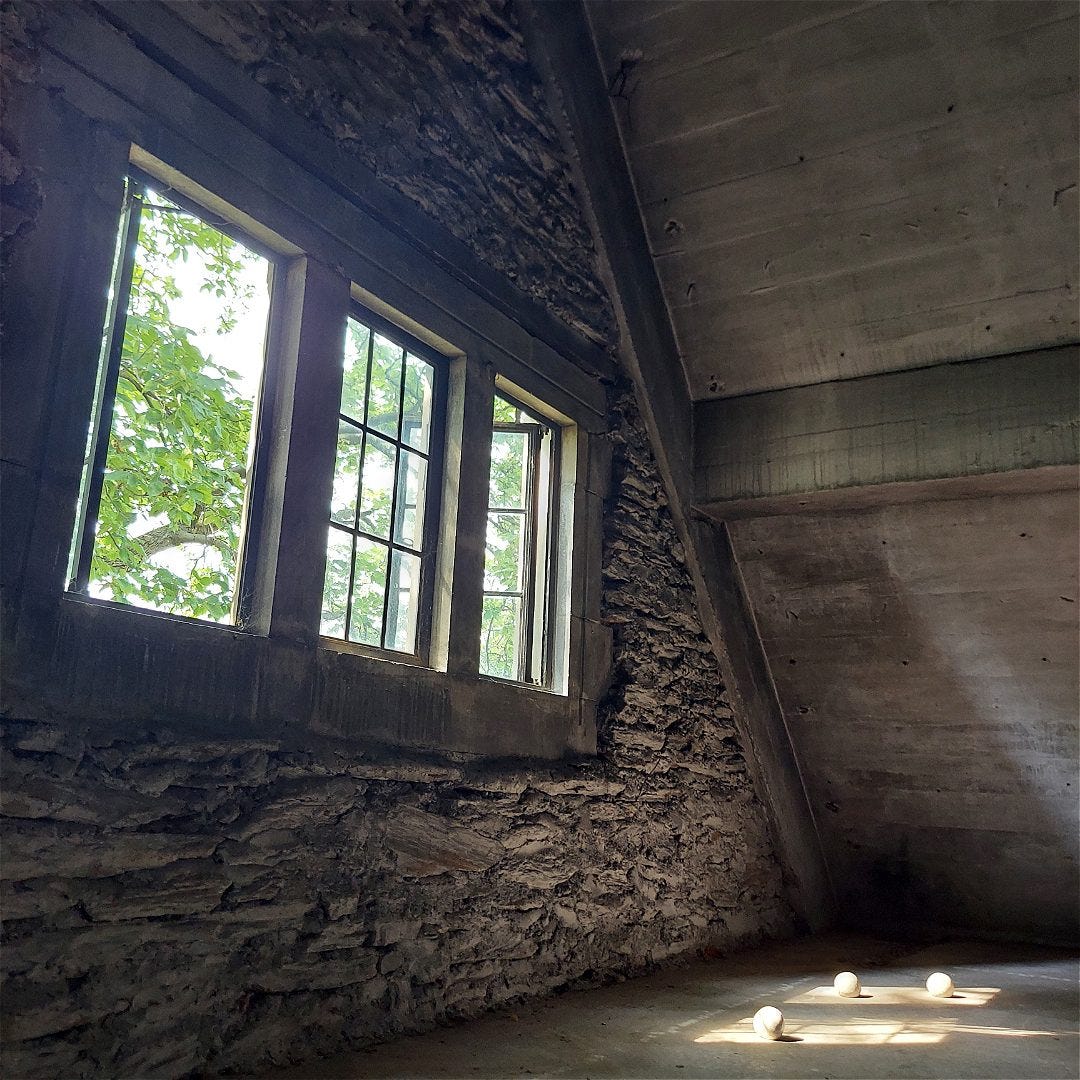
Hazard House — Stephen Dout
$20, Through September 17
I will not belabor the point that I didn’t enjoy Hazard House. A solo juggling show, Hazard House felt underbaked and under rehearsed. The production seemed a comedy of errors, not only the understandable ones fumbling objects or missing tricks, but less forgivable failures of planning; rube goldberg machines and domino chains that had weeks to plan failed to function, the production was interrupted multiple times for Doutt to trigger audio cues that could have been automated, and while the audience was moved throughout the space, scant attempts were made to engage them, thus dashing attempts at immersion.
I realize it’s not fair to judge a show based on what you want, instead of what it offered, but a bit more thought could have salvaged the troubled production. Especially in light immersive/site specific work, tone can smooth over most wrinkles. Using the spooky attic of the Philadelphia Circus Campus, Hazard House had ample material to work with tonally, starting strong with darkness and ominous heartbeats echoing in the space. And yet, that tone was discarded, the lighting going completely bright, and the audio switching to a mix of indifferent techno, pseudo-Burt Bacharach horns, and other kitsch. And yet, despite invoking attics and antiques occasionally, Hazard House refused to lean into the aesthetics of kitsch, embracing the silliness of the idea space. Either tone would have worked, but it was as if the production refused to make any decision.
Outside of his juggling, Doutt is a talented clown, and his lanky shrugs and sheepish grin made the evening of mistakes palatable, if not particularly engaging. Still, without a unique perspective or truly impressive technical artistry, I can’t recommend Hazard House.
BLACK WOOD — Gunnar Montana
$45, $350 VIP Table, Through October 31
The other night, I found myself watching The Wicker Man. No, not the garbage Nicholas Cage version (which I also love, for obviously different reasons), but the darker, steamier 1973 movie. Going through its tale of pagan madness and human sacrifice, I found myself in the odd position of a sort of giddy joy as opposed to horror. After all, as a queer Jewish man in modern America, I’m frequently the outsider. Yes, Summersisle is home to a murderous cult, but as a topsy-turvy mirror where they prey upon the state, the masculine, and the pious? There’s a certain twisted funhouse delight to us outsiders, the kind some women reported to me of their experiences watching similar cult delight Midsommar.
All of this is a means of introducing the world of BLACK WOOD, the latest of Gunnar Montana’s immersive burlesque fantasias. BLACK WOOD (shockingly for the burlesque space, the name is not a double entendre) is a dark fairy tale forest, in which a coven of witches perform their grizzly, giddy sacrifices. The choreography largely sees their practices as exuberant, or meditative, or rooted in love, no matter the horror of each vignette’s subject. The witches may sacrifice an innocent camper, but see how they joyously dance around his corpse, and ride the frame of his tent as a carnival ride, clutching each other lovingly and grinning as they spin through the air.
To be sure, Montana’s choreography and stagecraft is excellent. Creeping through the dark tunnels of the coven’s lair into a fully-realized forest clearing was as good an intro as the most lavish and large scale immersive productions. Dances were inventive, saucy, and rooted in burlesque without ever feeling pandering.
If I could point to any significant flaw, it would be in the second vignette, a fairly rote if expertly danced story of an abused woman awakening to her power as a witch, finally slaying her creep of a partner with the help of her coven. Not only did the sequence feel more derivative in an evening of otherwise entirely inventive sequences (yes, Gunnar, we’ve all seen AHS: Coven), but it disrupted the tone of the evening. When all other sequences found empowerment in feminine joy unshackled from morality, closer to the feral beauty of the werewolf fantasy than a typical witchcraft narrative, the return to the more traditional exploration of witchcraft within a violent gender binary felt jarring and disjointed.
This flaw, however noticeable, is at the very least dwarfed by the magnitude of the spectacle Montana crafts. I find myself in an almost twitchy state, fuming that I’ve missed previous Gunnar Montana productions. When even in this deep dark theme I found such wonder and exuberance, I can only imagine the full shotgun blast of sunshine that earlier, cheerful and sexy productions like Motel Montana and Bathhouse offered.
The fact that Gunnar Montana is only a household name among Philadelphians is a damn shame; not that Philadelphia isn’t a wonderful venue for his brand of queer burlesque. Moreso, I wish I could bottle and ship the experience of Gunnar Montana, this year in the spicy flavor of BLACK WOOD, across the world.
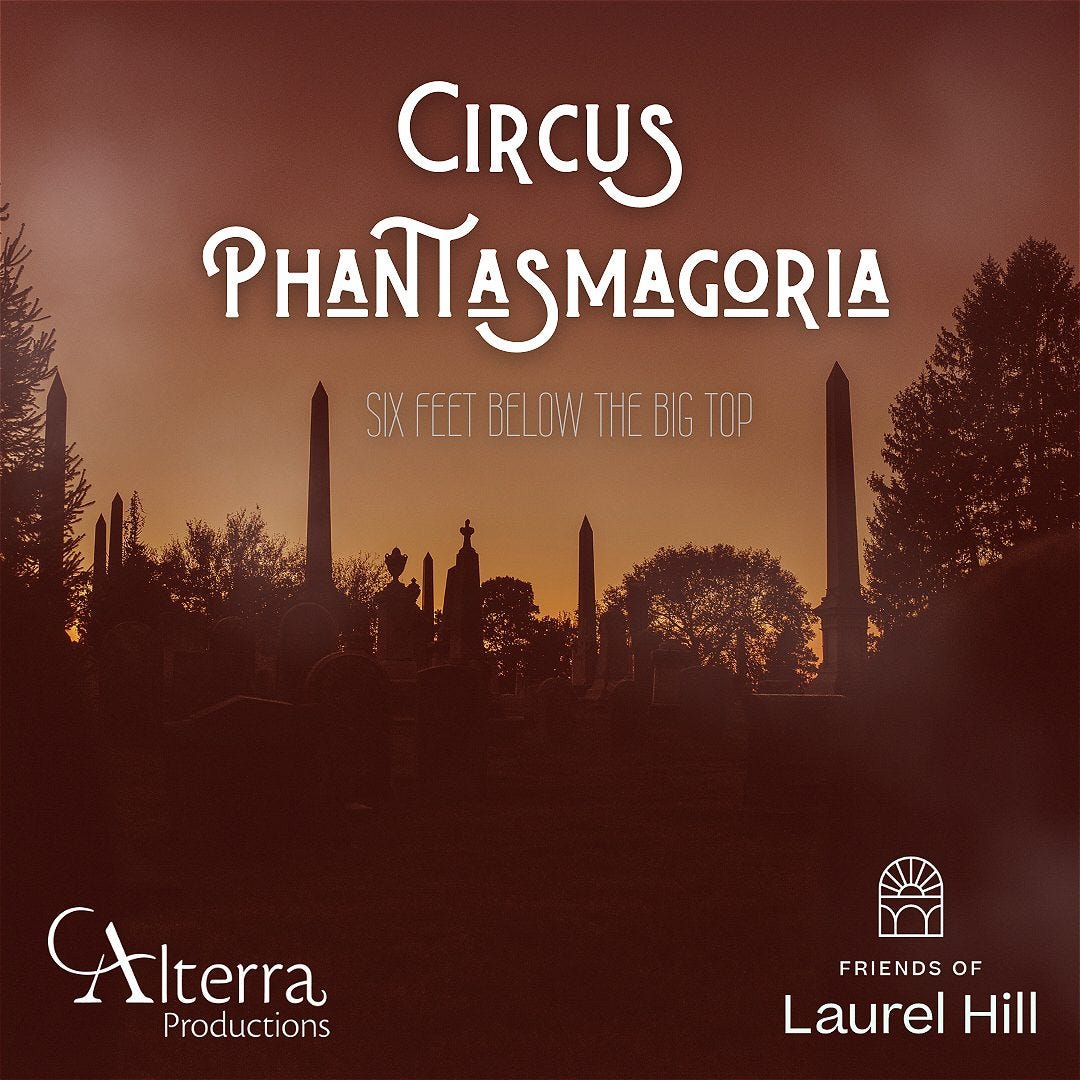
Circus Phantasmagoria — Alterra Productions
$45, Through September 30th
Jodorowsky, in his explanation of psychomagic, describes how everyone has a personal mythology. For many, larger religions or mythologies may shape it, but this internal, magical world is unique to everyone. While traditional psychomagical design tries to leverage universal archetypes to evoke a sense of magic in the viewer, Circus Phantasmagoria finds delight and meaning in the specific. The grounds of Laurel Hill East Cemetery become the mental landscape of a high school English teacher on the brink of death, with the audience free to wander up until the last moments in which his consciousness departs in the form of an elaborate aerial routine.
Yes, the environment fragments and characters that populate the dream escape take inspiration and form largely from Greco-Roman mythology, a favorite of both our protagonist and I, but we’re not witnessing any deities. Instead, it’s a strangely intimate experience, viewing the ways we try to conceptualize and grapple with our little joys and tragedies. While there are universally recognizable elements in these archetypes, and some answers to be found, elements of ambiguity (inevitable in a multi-track sandbox show) take on a sad poignancy, a manifestation of the impossibility of truly understanding anyone. And yet, the story, following our protagonist slowly accepting his death, is ultimately a cathartic one, finding peace amid the headstones. This isn’t to say there aren’t moments of pure delight. A table of various evocative perfumes, a clear homage to Erin Morgenstern’s Night Circus, was a highlight for me, as was the goth fantasy of slipping into a secret absinthe bar in a vintage mausoleum.
If design and themes are universally strong, the show’s technical execution is a bit more mixed. Sets are gorgeous and take advantage of Laurel Hill East’s grandeur. However, the relatively small cast is occasionally dwarfed by the space, with action sometimes sparse on the ground. This is usually fine in the beauty of the candlelit cemetery, though, giving moments for solitude and contemplation. While the circus finale is expertly performed, and in the grandest site in the cemetery, sight lines are occasionally a bit wonky. Still, these feel like minor distractions, and overall don’t reduce the quality of the evening.
Get Blake Weil’s stories in your inbox
Join Medium for free to get updates from this writer.
SubscribeSubscribe
Circus Phantasmagoria embraces a new tone for Alterra, a bit moodier and definitely on the more somber side of things. The show definitely delivers the promised circus spectacle, but also leaves me with a bit more to chew on. Alterra’s work is increasingly emotionally complex, and I look forward to their continued evolution as a company.
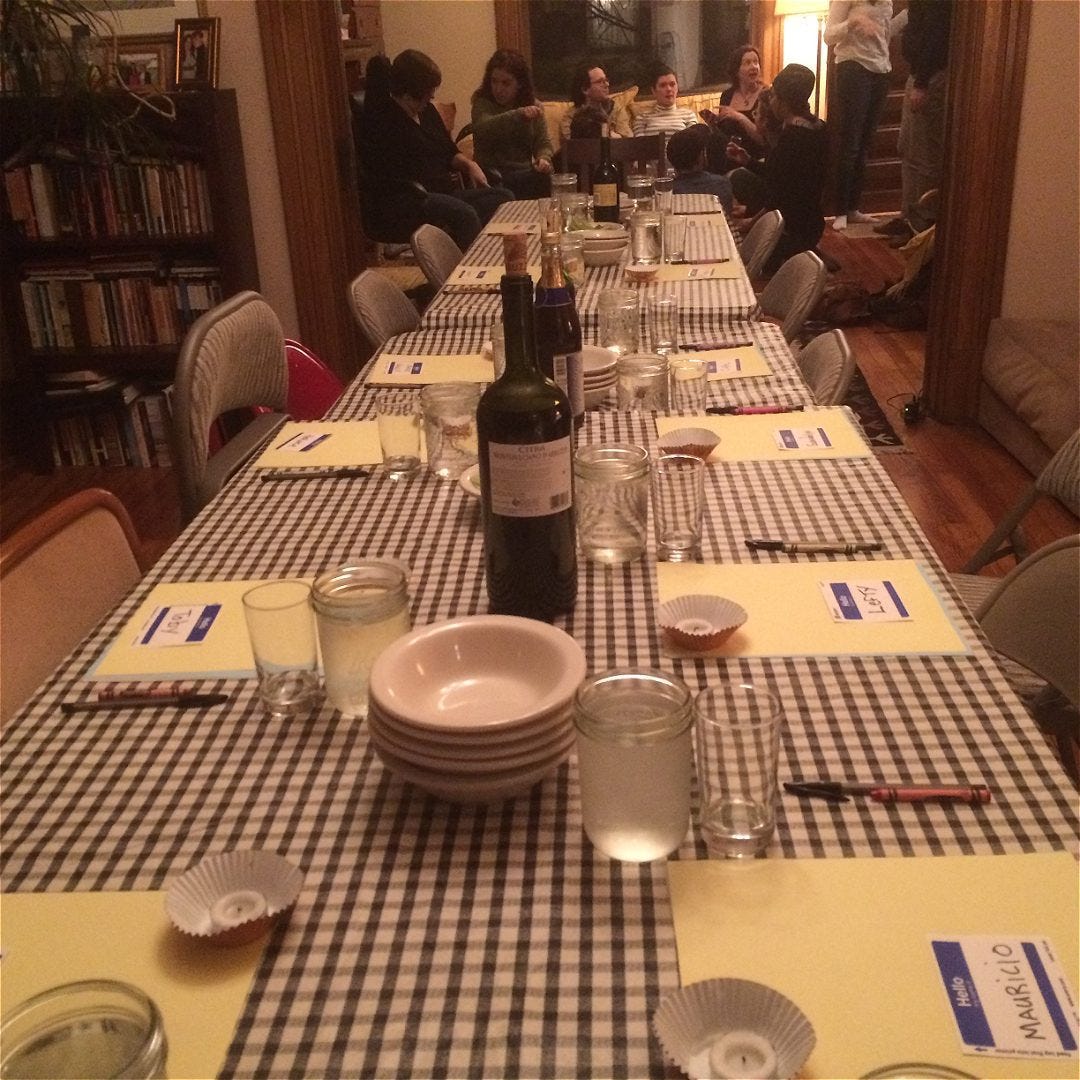
Tristan Tzara Was My Best Friend in Junior High — Savannah Reich
$20, Run Concluded
It may be hack writing to open with a definition, but as Seder means “order”, that knowledge is vital in understanding that Dadaism is possibly the funniest counterpoint on offer. Tristan Tzara Was My Best Friend in Junior High invites us to the Seder table of Tzara (Jon Cole, wonderfully needy and neurotic) himself, author of the Dada Manifesto of 1918. Dada, by artistic intention, destroys order, designed as an anti-meaning bomb to shock the art world.
Yes, the framework of a Seder is here, four cups of wine, four questions, bitter herbs, spilled wine for the plagues, but meaning has gone out the window from the moment we arrive. I am given my nametag (“Borax”). I am seated between House Cat and Clytemnestra. Instead of the exodus from Egypt, we hear the parable of Batman and Robin. Instead of the herbs representing the bitterness of slavery, the celery represents celery, just an isolated and fetishized vegetable in the Marxist sense of the word. Order gives way to anarchy, to freedom from any vision or philosophy.
Or does it? After all, the evening is being led by a Seder leader (Mr Stine, elegantly commanding the audience’s attention while maintaining vulnerability and superb comedic timing). The topic also seems to keep drifting back to Tzara, and how grateful he is to have us all as a community of friends, unlike certain ungrateful surrealists who recently abandoned him. Even the ten plagues become the ten sins of the surrealists against Tzara, ranging from inappropriate claims of manifesto authorship to needy demands for rides to the airport.
An exploration of the artistic philosophy of Dada may be the entry point (chaos against Seder), but the other core of the Seder table ends up thematically winning out: community. After all, who comes to a Seder but a people defined by their traditions. And by gathering here, and declaring it the first and only instance of a new tradition, have we not become a people?
No, of course we haven’t, but my God do we want to. The evening speedruns the formation and dissolution of a community, as Tzara attempts to cling to a new place to belong. As is common to much immersive theatre, we arrive as strangers, and engage in ritual for its own sake. Through this process, we become a collective. What’s unique is how the show then proceeds to break us, remind us of the illusion, remind us of how if we stayed together, we’d have nothing in common and would end as badly as Tzara and Breton, leader of the surrealists, or even worse, Breton and Cocteau several years later as Surrealism underwent an even more violent schism of its own. If Tzara truly embraces any artistic dogma, it seems to be Brecht’s theories on alienation and violating suspension of disbelief in theatre, but targeted to the interpersonal as opposed to the political and economic.
The piece, conceived by Savannah Reich, was originally performed in private homes and it shows in the best way possible. Despite an audience size of approximately thirty, the production feels intimate, and while the audience only rarely speaks, the evening takes a conversational tone. Certainly, as audience read-aloud scripts and participation prompts grow stranger and more offbeat, the fact that most of the audience has kept up with the traditional four cups of Seder wine helps break down any barriers.
Being in a relationship, or a friendship, or a community is hard. We cling and demand, or we’re clung to and demanded of and grow resentful. We hurt each other, steal each other’s girlfriends, force people into our projects and then get angry when they’re not enthusiastic. It’s tempting to throw your hands up, but we’re social creatures. We need this, however ugly it is. Tristan Tzara Was My Best Friend in Junior High illustrates this need, and then skillfully argues that need alone makes us a community, a people, despite the inevitability of our failure.
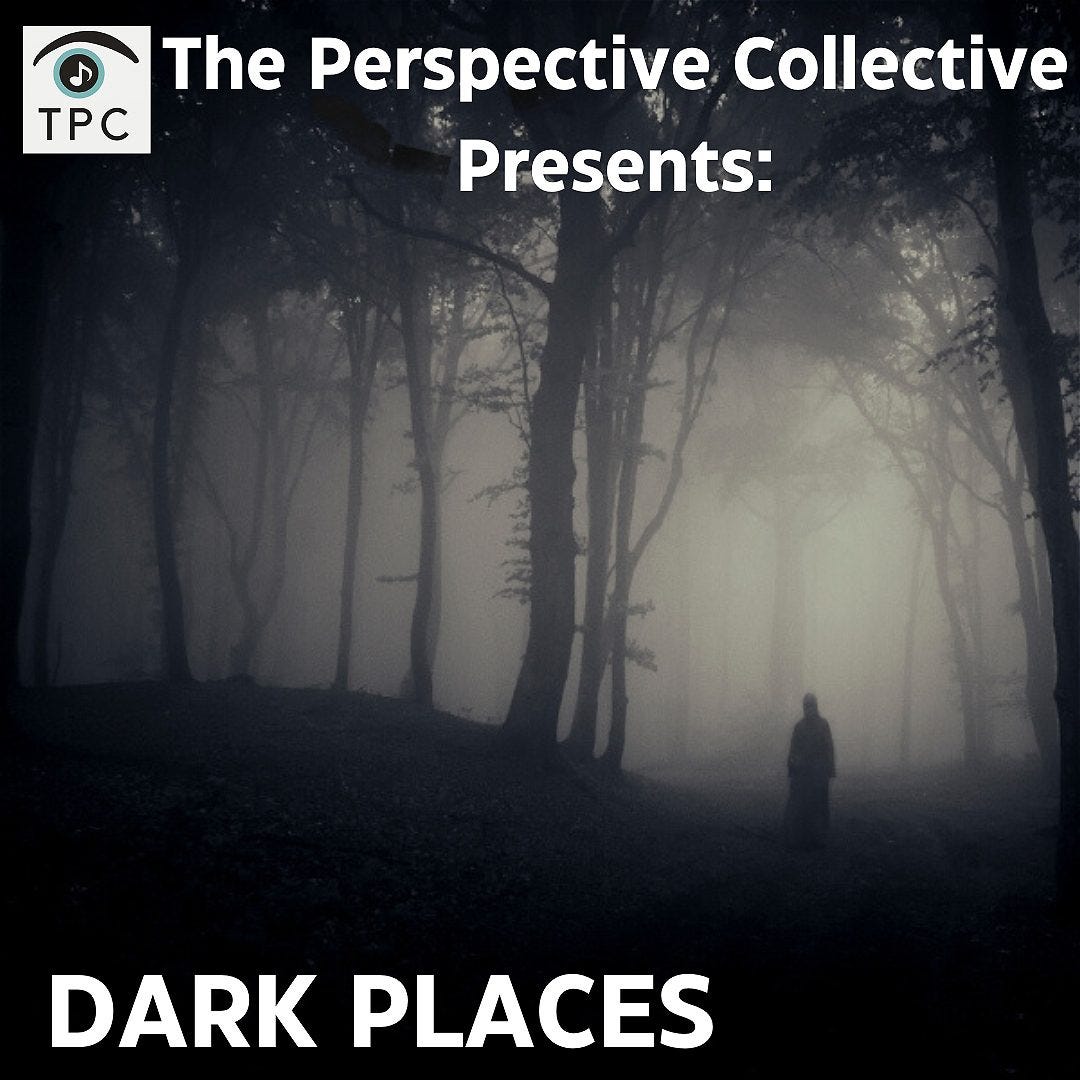
Dark Places — The Perspective Collective
$15, Run Concluded
I get so caught up in the far reaches of immersive theatre, chasing people around warehouses clad in maks, simulating break-ins to performers’ apartments, etc. that sometimes I forget how pleasant pure site specificity is. Laurel Hill East is a gorgeous cemetery, filled to bursting with crypts and mausoleums, the permanent home of the who’s-who of turn of the century Philadelphia. The Perspective Collective, a small chamber opera ensemble mostly devoted to new works, leveraged the power of the cemetery space for an evening of opera on themes of the macabre.
While I’m no great judge of opera, the singers were all talented, and gamely sang against the pour of a sudden rainstorm. It’s difficult to provide a full summary of the evening in light of that storm. No matter the quality of the work, for better or worse, the audience was distracted trying to position and reposition their umbrellas, straining to hear above the deluge.
I can more effectively judge the selection of works though. The Perspective Collective programmed a fun evening, ranging from an almost Gilbert and Sullivan-esque mini-opera taken from the confessions of Dr. H.H. Holmes, culminating in a short one-act opera of Hawthorne’s Young Goodman Brown. While the opener, a soulful aria about the Great Boston Fire, was one of the musical hits of the evening, it seemed slightly incongruous with the rest of the program’s focus on the human capacity for evil born of selfishness.
For fifteen dollars, Dark Places is a great intro for newcomers to opera, and I hope they continue to work with Laurel Hill. I also hope for less inclement weather, but the evening was pleasant enough I’m willing to roll with the punches.

Tea Party at the End of the World — Jessica Creane
$35, Run Concluded
Not to be the girl who returned home from Paris, baguette in hand and beret on head, but studying abroad changed me. That is to say, among other things, it made me briefly terrified of dying.
To clarify, I wasn’t necessarily so depressed beforehand. Moreso, I was unconcerned. Life seemed a mix of pleasures and pains, and while certainly sad to end the former, the balance of the mix softened the blow. Then came a few weeks of perfection in Tokyo though, with friends who doted on me, mild campus celebrity status, delicious food and new adventures every day. Suddenly, the calculus shifted, and death became a horrifying inevitability.
Jessica Creane, with her usual vulnerability and warmth, wrestles with similar themes on both the personal and global level in her Tea Party at the End of the World. Developed in response to a trip to the arctic with fellow artists to witness the climate apocalypse first hand, and to her father’s recent passing, the show could feel dreary and morbid. Instead, Creane focuses us on the comforts of physical reality that brought her through these experiences. Namely, tea and parlor games. The cottage of the MAAS building, a Philadelphia performing arts center that plays host to many of Fringe’s smaller productions, became a bubble in time and space, and all of us summoned for a few cups of tea as we await the heat death of the universe with Creane, far far in the future.
The audience is seated, and the show finds a comfortable rhythm, alternating between explanations of the teas Creane prepares, monologues, and space for the audience to share responses to gentle yet probing questions. These question and answer sessions, framed as the aforementioned parlor games, are incredibly calibrated. Ranging from meditating on what you’d want your last day to be like, to imagining ways you surely wouldn’t die, they find a sense of pleasure and warmth in the existential. As can be expected from any mixed audience, answers ranged from the serious to out of place attempts at humor. And yet, any response worked. After all, what wouldn’t be appropriate in the absurd face of death? We have no good responses, and the range illustrated that well.
So, if there are no good responses, how do we deal with this? The world’s falling apart, physically, socially, spiritually. Creane gently, if expertly, reminds us how painful the passing of a loved one is. If we love earth, if we love being alive, isn’t the apocalypse just that writ large?
Tea, a nearly universal symbol of culture, refinement, and peace is an expertly chosen counterpoint. The brews are superb, and each sip feels like a sort of defiant enlightened hedonism. Playing host to us at the end, Creane starts the show projecting an attempt at distraction and dissociation, but it quickly becomes apparent this is its own form of wisdom. Ultimately, in the face of the existential, Creane effectively argues we do have one good answer: kindness to ourselves and others.

Privy Privy — Donna Oblongata and Partick Costello
$5, Run Concluded
When was the last time you honest-to-god indulged yourself? When you did something not because it was productive, or helped support productivity? Beyond that, no restrictions. No rationing, or trying to stretch things out. Endless thinkpieces describe us, between TikTok and Amazon, as living in an age of instant gratification, but have you recently felt gratified? Moreso, it feels that what we’re really experiencing is something closer to the fast food of pleasure, designed not to gratify or satisfy, but to be a quick pick-me-up to keep us drip fed on enough dopamine to be more productive. I catch myself thinking constantly of pleasure as a means to an end, indulgence a way of scratching an itch that would distract from worthwhile pursuits.
Of course, this is foolish. Pleasure is its own end, even if we tend to pathologize it as something shameful. In that way, Privy Privy is incredibly well conceived in the way it links the shame and stigma that has historically secreted queer pleasure away from the world, and the pleasure of an indulgent ice cream feast. The concept is simple, even if the execution is an over-the-top bathhouse extravaganza. You step into a bathroom stall, a double wide glory hole waiting for you. You get down on your knees, and instead of the typical interaction, you get anonymously hand fed an ice cream cone through the hole.
As said earlier, the experience spares no extravagance. A muscle bear dressed as a sexy soda jerk is constantly creeping up behind me, drizzling sauces and cream and sprinkle over the cone that’s being mashed in my face. A vintage bathhouse disco mix is pumping, with swirling theatrical fog and disco lights. A gogo dancer dressed as a large cone undulates in one corner, next to the toppings bar. The entire experience is camp enough that even the slightly shy could succumb to giggles.
Still, something strangely magical happened on my knees in that stall, and that’s that I engaged in pleasure for its own sake. Art imitating life, yes, my face did get suggestively coated in a thick layer of melted ice cream. My tongue grew numb as flavor after flavor of sauce, countless showers of sprinkles and squirts of whipped cream were introduced. My mind was basically on fire of just the sensation alone, with no concern for context, or relationships, or how I looked. In a strange twist, it felt like the most moral act of selfishness I ever indulged in.
And yet, was it selfish? If we return to the context of the piece, I’m also giving the hand that feeds me metaphorical pleasure. I’m in a place of communal joy, representative of a haven for those persecuted, both past and present. Pleasure and desire become a form of resistance, a choice of active joy in the face of attempted obliteration.
Good art changes you, and at the very least this changed how I feel every time I eat ice cream. I hope the world changes enough that pleasures that hurt no one don’t have to continue to hide in stalls or dark, hidden spaces. I hope you do something nice for yourself tonight.
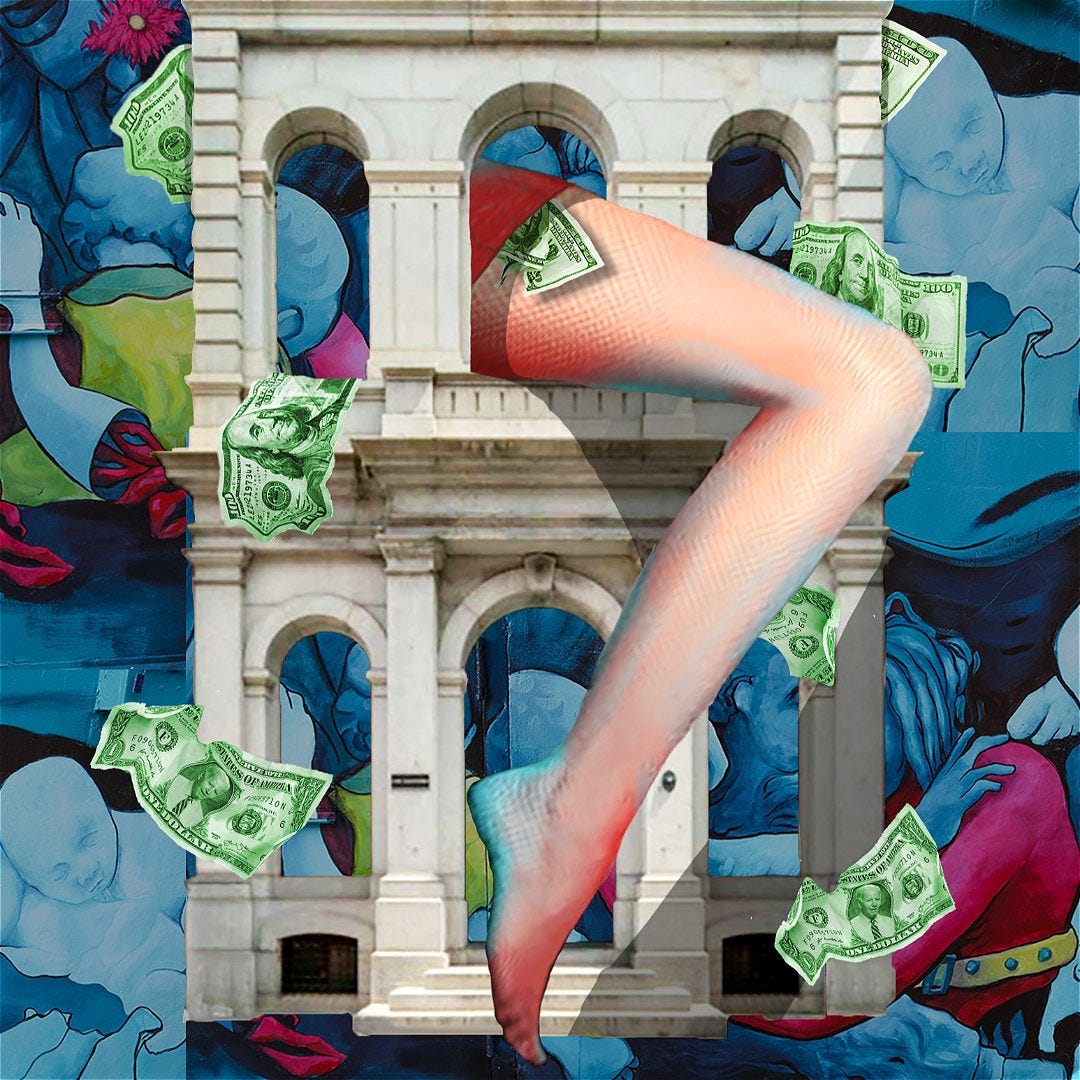
Make Bank — A Meg Saligman Production Featuring Rough and Tumble Productions, Directed by Terry Guerin
$35, Run Concluded
All currency is fundamentally absurd when you think about it. No, xX_libertarian-k1ng420_Xx, gold doesn’t have inherent value. At least the Roman legion, paid in salt (the origin of the word salary), could use it to some survival end. For anyone who’s taken basic economics, it’s understood that all currency is merely worth the value that we place on it. This raises the obvious question though, when you move from Econ 101 to Philosophy 101; what do we actually value?
Make Bank makes beauty and joy out of this absurdity. Meg Saligman, known for her immense murals, has transformed the Manufacturer’s National Bank into a kaleidoscope eye on the entire financial system. The building, refurbished and open to the public for the first time since 1985, is now a collage of places and eras in the history of finance, from the Aztec empire to the tulip bubble of Holland.
Patrons interact with both the tellers of the bank and representatives of each historical era to beg, barter, and steal mountains of trinkets to assemble absurd, glittering statues. No currency is exchanged, though: instead, you might buy earrings with a secret, or some old crystal goblets with a song. We’re instructed as we enter that time is money, and that we need to spend our hour in the space wisely, bringing us elegantly to the question of value.
In my case, more than the time to assemble statues, I valued time with my date watching the stupendous burlesque acts. From the Dutch tulip girl stripping to schlock classic “Tiptoe through the Tulips” and ABBA’s “Money Money Money”, to her “cash cow” in tiny cow print underwear doing a reverse striptease singing “9 to 5” (with a full chorus of bank tellers), the production seemed to revel more in humor and warmth than titillation. The spectacular finale in which an aerialist acrobat descended from the ceiling on silks to rob the bank was the perfect cap to the evening, another funhouse mirror distortion of capital’s inherent silliness.
As I stood at the end of the show, showered in both fake bills and international currency devalued enough to be worth about as much as the Monopoly money, I had a strange sort of lightness to me. Money was, for a brief evening, not an object of anxiety, or even really an object of desire. It was just an object, divorced from all of our emotions. Free from that gravity, we all giggled, and did shots, and sang along to Dolly Parton. Without the crushing responsibility of spending currency, I felt actually empowered to spend my time. It was a nice fantasy, for an evening, to see that anarchic spirit take over a banking space.
I realized as I walked away that student loan payments and interest were set to resume in just a few short hours. Oh well. All the more important that we dream, then.
Discover the latest immersive events, festivals, workshops, and more at our new site EVERYTHING IMMERSIVE, new home of NoPro’s show listings.
NoPro is a labor of love made possible by our generous Patreon backers. Join them today!
In addition to the No Proscenium website, our podcast, and our newsletters, you can find NoPro on Facebook, LinkedIn,YouTube, Twitter, Instagram, in the Facebook community Everything Immersive, and on our Patreon Backer exclusive Discord.